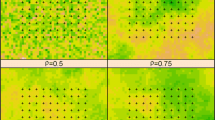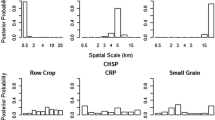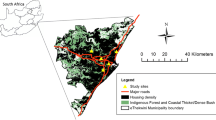Abstract
Scale is important to consider when investigating effects of the environment on a species. Breeding Bird Survey (BBS) data and landscape metrics derived from aerial photographs were evaluated to determine how relationships of bird abundances with landscape variables changed over a continuous range of 16 spatial scales. We analyzed the average number of birds per stop (1985–1994) for five songbird species (family Cardinalidae) for each of 50 stops on 198 BBS transects throughout six states in the Central Plains, USA. Land along each transect was categorized into six cover types, and landscape metrics of fractal dimension (a measure of shape complexity of habitat patches), edge density, patch density, and percent area were calculated, with principal components used to construct composite environmental variables. Associations of bird abundances and landscape variables changed in accordance with small scale changes. Abundances of three species were correlated with edge density and one with component I, which subsumes initial variables of patch density for urban, closed forest, open forest, and open country. Fractal dimension and component II (summarizing amount of closed forest versus open country) were associated with the most species. Correlation patterns of fractal dimension with northern cardinal (Cardinalis cardinalis) and painted bunting (Passerina ciris) abundances were similar, with highest correlations at intermediate to small scales, suggesting indirectly that these species thrive in areas where local habitat conditions are most important. Multiscale analysis can provide insight into the spatial scale(s) at which species respond, a topic of intrinsic scientific interest with applied implications for researchers establishing protocols to assess and monitor avian populations.
Similar content being viewed by others
References
Blank, S., Seiter, C. and Bruce, P.: 2001, Resampling Stats in Excel, Resampling Stats Inc., Arlington, VA.
Böhning-Gaese, K.: 1997, ‘Determinants of avian species richness at different scales’, J. Biogeogr. 24, 49–60.
Bolger, D. T., Scott, T. A. and Rotenberry, J. T.: 1997, ‘Breeding bird abundance in an urbanizing landscape in coastal southern California’, Conserv. Biol. 11, 406–421.
Brennan, S. P.: 2004, ‘Relationship of bird abundances and landscape characteristics at multiple scales’, M.S. Thesis, University of Oklahoma, Norman OK.
Certain, D. L.: 2000, ‘A multiscale analysis of nest-site choice, nest success, and population abundance in the scissor-tailed flycatcher’, Ph.D. Dissertation, University of Oklahoma, Norman, OK.
Dow, D. D.: 1969, ‘Habitat utilization by cardinals in central and peripheral breeding populations’, Can. J. Zool. 47, 409–417.
Drolet, B., Desrochers, A. and Frotin, M.: 1999, ‘Effects of landscape structure on nesting songbird distribution in a harvested boreal forest’, Condor 101, 699–704.
Flather, C. H. and Sauer, J. R.: 1996, ‘Using landscape ecology to test hypothesis about large-scale abundance patterns in migratory birds’, Ecology 71, 28–35.
Fuhlendorf, S. D., Woodward, A. J. W., Leslie, D. M. Jr. and Shackford, J. S.: 2002, ‘Multi-scale effects of habitat loss and fragmentation on lesser prairie-chicken populations of the US Southern Great Plains’, Landscape Ecol. 17, 617–628.
Halkin, S. L. and Linville, S. U.: 1999, ‘Northern Cardinal (Cardinalis cardinalis)’, in: A. Poole and F. Gill (eds), The Birds of North America, no. 440, Academy of Natural Sciences, Philadelphia, PA, and American Ornithologists’ Union, Washington, DC.
Hecnar, S. J. and M’Closkey, R. T.: 1997, ‘Spatial scale and determination of species status of the green frog’, Conserv. Biol. 11, 670–682.
Ingold, J. L.: 1993, ‘Blue Grosbeak (Passerina caerulea)’, in: A. Poole and F. Gill (eds), The Birds of North America, no. 79, Academy of Natural Sciences, Philadelphia, PA.
Kopachena, J. G. and Crist, C. J.: 2000, ‘Macro-habitat features associated with painted and indigo buntings in northeast Texas’, Wilson Bull. 112, 108–114.
Kotliar, N. B. and Wiens, J. A.: 1990, ‘Multiple scales of patchiness and patch structure: A hierarchial framework for the study of heterogeneity’, Oikos 59, 253–260.
Lowther, P. E., Lanyon, S. M. and Thomspon, C. W.: 1999, ‘Painted Bunting (Passerina ciris)’, in: A. Poole and F. Gill (eds), The Birds of North America, no. 398, Academy of Natural Sciences, Philadelphia, PA, and American Ornithologists’ Union, Washington, DC.
MacFaden, S. W. and Capen, D. E.: 2002, ‘Avian habitat relationships at multiple scales in a New England forest’, For. Sci. 48, 243–253.
McGarigal, K. and Marks, B. J.: 1995, ‘FRAGSTATS: Spatial Pattern Analysis Program for Quantifying Landscape Structure’, General Technical Report PNW-GTR-35, Pacific Northwest Research Station, Forest Service, US Department of Agriculture, Portland, OR.
McGarigal, K. and McComb, W. C.: 1995, ‘Relationships between landscape structure and breeding birds in the Oregon coast range’, Ecol. Monogr. 65, 235–260.
Meyer, C. B., Miller, S. L. and Ralph, C. J.: 2002, ‘Multi-scale landscape and seascape patterns associated with marbled murrelet nesting areas on the U.S. west coast’, Landscape Ecol. 17, 95–115.
Miller, J. N., Books, R. P. and Croonquist, M. J.: 1997, ‘Effects of landscape patterns on biotic communities’, Landscape Ecol. 12, 137–153.
Naveh, Z. and Lieberman, A. S.: 1984, Landscape Ecology: Theory and Application, Springer Verlag, New York, NY.
O’Connor, R. J., Jones, M. T., White, D., Hunsaker, C., Loveland, T., Jones, B. and Preston, E.: 1996, ‘Spatial partitioning of environmental correlates of avian biodiversity in the conterminous United States’, Biodivers. Lett. 3, 97–110.
Parmelee, D. F.: 1959, ‘The breeding behavior of the painted bunting in southern Oklahoma’, Bird-Banding 30, 1–19.
Payne, R. B.: 1992, ‘Indigo bunting (Passerina cyanea)’, in: A. Poole and F. Gill (eds), The Birds of North America, No. 4, Academy of Natural Sciences, Philadelphia, PA.
Pribil, S. and Picman, J.: 1997, ‘The importance of using proper methodology and spatial scale in the study of habitat selection by birds’, Can. J. Zool. 75, 1835–1844.
Robbins, C. S., Bystrak, D. and Geissler, P. H.: 1986, ‘The breeding bird survey: Its first fifteen years 1965–1979’, USFWS Resource Publication no. 157, Washington, DC.
Rohlf, F. J.: 2003, NTSYSpc: Numerical Taxonomy and Multivariate Analysis System, Exeter Software, Setauket, NY.
Saab, V.: 1999, ‘Importance of spatial scale to habitat use by breeding birds in riparian forest: A hierarchical analysis’, Ecol. Appl. 9, 135–151.
Simon, J. L.: 1997, Resampling: The New Statistics, Resampling Stats Inc., Arlington, VA.
Tarvin, K. A. and Garvin, M. C.: 2002, ‘Habitat and nesting success of blue jays (Cyanocitta cristata): Importance of scale’, Auk 119, 971–983.
Temple, S. A.: 2002, ‘Dickcissel (Spiza americana)’, in: A. Poole and F. Gill (eds), The Birds of North America, no. 703, Academy of Natural Sciences, Philadelphia, PA, and American Ornithologists’ Union, Washington, DC.
Van Horssen, P. W., Schot, P. P. and Barendregt, A.: 1999, ‘A GIS-based plant prediction model for wetland ecosystems’, Landscape Ecol. 14, 253–265.
Vickery, P. D., Tubaro, P. L., Cardosa, J. M., Peterjohn, B. G., Herkert, J. R. and Cavalcanti, R. B.: 1999, ‘Conservation of grassland birds in the Western Hemisphere’, Stud. Avian Biol. 19, 2–26.
Westphal, M. I., Field, S. A., Tyre, A. J., Paton, D. and Possingham, H. P.: 2003, ‘Effects of landscape pattern on bird species distribution in the Mt. Lofty ranges, South Australia’, Landscape Ecol. 18, 413–426.
Wiens, J. A.: 1989, ‘Spatial scaling in ecology’, Funct. Ecol. 3, 385–397.
Wiens, J. A., Addicott, J. F., Case, T. J. and Diamond, J.: 1986, ‘Overview: The Importance of Spatial and Temporal Scale in Ecological Investigations’, in: J. Diamond and T. J. Case (eds), Community Ecology, New York, NY, pp. 145–153.
Wiens, J. A., Rotenberry, J. T., and Van Horne, B.: 1987, ‘Habitat occupancy patterns of North American shrubsteppe birds: The effects of spatial scale’, Oikos 48, 132–147.
Zimmerman, J. L.: 1993, The Birds of Konza, University of Kansas Press, Lawrence, KS.
Author information
Authors and Affiliations
Corresponding author
Rights and permissions
About this article
Cite this article
Brennan, S.P., Schnell, G.D. Relationship Between Bird Abundances and Landscape Characteristics: The Influence of Scale. Environ Monit Assess 105, 209–228 (2005). https://doi.org/10.1007/s10661-005-3694-x
Received:
Accepted:
Issue Date:
DOI: https://doi.org/10.1007/s10661-005-3694-x




